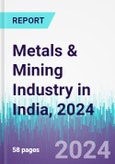The expansion of sectors like construction, automotive, and electronics is intricately linked to the increasing demand for metals. As India advances in its economic development, the metal and mining industry plays a crucial role in meeting these demands and driving industrial progress. Essential requirements include iron ore for steel production, bauxite and alumina for the aluminium industry, copper for electrical applications, and coal for energy generation. Major industry contributors, including Vedanta Limited, Coal India Limited, Hindalco Industries Limited, National Aluminium Company Limited, and Hindustan Zinc Limited, shape the sector's growth. The metals & mining industry production increased from 1,032.15 million tonnes in 2018 to 1,217.59 million tonnes in 2023, expanding at a compound annual growth rate (CAGR) of ~3.36% during this period.
Governmental initiatives:
The Ministry of Steel has established 57 Memorandum of Understanding (MoUs) with 27 companies, projecting an investment of around INR 300 billion for creating an additional capacity of approximately 25 million tonnes (MT) of specialty steel over the next five years. The government unveiled a new INR 120 billion PLI scheme on September 18, 2023, aimed at revitalizing the manufacturing of heavy mining and construction equipment. The scheme seeks to reduce import dependence and stimulate job creation in a sector vital for rapid infrastructure development.Market Influencers:
Market drivers:
The mining and metal industry in India significantly contribute to the nation's economic growth by providing crucial raw materials for diverse industries, supporting infrastructure development, and manufacturing essential products. The government aims to introduce investor-friendly regulations, and Union Minister Pralhad Joshi encourages stakeholders to elevate the sector's GDP contribution to 2.5% by 2026-27, highlighting the industry's robustness, particularly evidenced by the abundant iron ore reserves in Goa. India is presently the world's third-largest consumer of electricity, but it is projected to surpass the United States by 2030, becoming the second-largest consumer. The surge in electricity consumption is driven by ongoing electrification initiatives in rural areas, urbanization, and industrial expansion, with coal being the primary source, constituting 60% of total power generation, leading to increased demand for both electricity and metals like copper essential for electrical applications.Critical deterrents to the growth of the market:
Mining activities have the potential to cause environmental harm, including erosion, sinkholes, biodiversity loss, and pollution of soil, groundwater, and surface water. Additionally, these operations contribute to climate change through carbon emissions, and their social consequences encompass community displacement, land and livelihood loss, and health hazards. The entire lifecycle of mining, from exploration to decommissioning, can have both positive and negative impacts on social and environmental systems, altering land use, causing deforestation, and disrupting animal migratory routes through associated infrastructure development.Table of Contents
Chapter 1: Executive summaryChapter 2: Socio-economic indicators
Chapter 3: Introduction
Chapter 4: Market overview
Chapter 5: Market segmentation
Chapter 6: Market influencers
Chapter 7: Government Initiatives
Chapter 8: Competitive landscape
Chapter 9: Recent developments
Chapter 10: Appendix
Companies Mentioned
- Coal India Limited
- Gujarat Mineral Development Corporation
- Hindalco Industries Limited
- Hindustan Zinc Limited
- National Aluminium Company Limited
- National Mineral Development Corporation
- Vedanta Limited
Methodology

LOADING...








